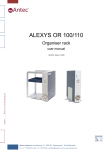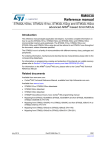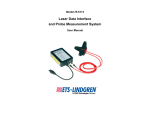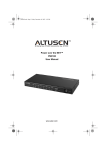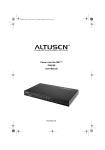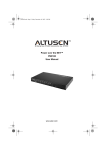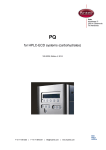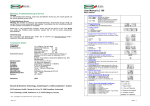Download 182_0027_01
Transcript
ALEXYS LC 100 Pump PQ Edition 1, 2006 182.0027 Table of contents 1 (of 17) Identification The undersigned engineer certifies that he/she is trained and qualified to perform an PQ on the LC 100 pump. Performer: Name Signature Initials Company Title: (Anted Leyden representative trained and qualified to perform PQ procedures) The undersigned reviewer/customer accepts that the above-mentioned engineer is trained and certified to do PQ/OQ on all Antec Equipment. Reviewer/ Customer: Name Signature Company: Title: (Owner-designated authorized person) Verified by (customer): ………………………….. Comments: Deviations (Y/N): …… Initials 2 (of 17) PQ procedure LC 100 pump, edition 1 Instrument LC 100 Pump head Manufacturer p/n: s/n: Analytical / Micro Antec Leyden Supplier Date of delivery Warranty until Test equipment AC 100 Part number Serial number Calibration date or Line recorder Model Serial number Calibration date Flow meter Model Serial number Calibration date ALEXYS data system Revision Verified by (customer): ………………………….. Comments: Deviations (Y/N): …… Table of contents 3 (of 17) Table of contents Identification 1 Instrument 2 Test equipment 2 Table of contents 3 Introduction 5 PQ for LC 100 pump 7 Test configuration 7 Pressure pulsations test 8 Flow rate deviation test 12 PQ certification 15 Comments 16 Non-conformance record 17 Verified by (customer): ………………………….. Comments: Deviations (Y/N): …… 4 (of 17) PQ procedure LC 100 pump, edition 1 Verified by (customer): ………………………….. Comments: Deviations (Y/N): …… Chapter 1 Introduction C H A P T E R 5 (of 17) 1 Introduction This document describes the Operational Qualification procedure as advised by the manufacturer. It is a result from our interpretation of many regulations and laboratory practises. In addition, feedback from users and representatives helped us to finalize this procedure. A complete PQ for the LC 100 pump consists of two qualification checks. The following test procedures should be executed to check if the pump operates within specifications: • • Flow rate deviation measurement Residual pressure pulsation measurement It may be necessary to re-adjust the pump in case the performance specifications are not met. For detailed information about pump readjustment consult the LC 100 service manual (p/n 182.0020). All qualification checks have to be approved, or should be marked "n/a" if not applicable. Any deviation observed must be documented in the 'nonconformance' record. All relevant documents regarding this operational qualification must be filed together in one location. As regulations and customer requirements may change, manufacturer reserves the right to introduces changes without prior notice. For details on functionality, operation and theory reference is made to the instrument users manual. Verified by (customer): ………………………….. Comments: Deviations (Y/N): …… 6 (of 17) PQ procedure LC 100 pump, edition 1 Verified by (customer): ………………………….. Comments: Deviations (Y/N): …… Chapter 2 PQ for LC 100 pump C H A P T E R 7 (of 17) 2 PQ for LC 100 pump Test configuration Mobile phase Piston wash Capillary Flow meter P P signal Pmonitor kappa Degassed & filtered HPLC-grade water HPLC-grade water 1/16” PEEK restriction capillary (127 um I.D) calibrated flowmeter or graduated analytical pipette & stopwatch system pressure between 100 - 200 bar Analog pressure output of the pump monitored using an AC 100 and ALEXYS data system software, sampling frequency 10 Hz, or line-recorder LC 100 time constant: high (2 sec) 45 (compressibility) PC AC 100 Restriction Capillary Pressure signal Time const 2s, Fsampling 10 Hz Flowmeter waste Pump Degasser 0.2 um filter HPLC-grade water Fig. 1. Test set-up for measuring flow rate deviation & pressure pulsation. Before running a PQ test the pump should be running for at least 5 minutes under the specified test conditions. Verified by (customer): ………………………….. Comments: Deviations (Y/N): …… 8 (of 17) PQ procedure LC 100 pump, edition 1 All tests described in the PQ procedure are based on a LC 100 with analytical pump head. In case of a LC 100 with micro pump head all flow rates mentioned in the tests should be changed accordingly. The flow rate of the micro head should correspond to the same flow rate in % FS (Full Scale) as the analytical pump head. The PQ tests are performed at 20 and 40% FS which corresponds to the following flow rates: Analytical Micro 20 % FS 1 mL/min 200 μL/min 40 % FS 2 mL/min 400 μL/min Pressure pulsations test Before starting the Pressure pulsation test download the latest version of the zip file "LC100_P-test_revxx.zip" from the Antec web site at http://www.antecleyden.com/. The zip file contains ALEXYS system and method files to perform the test, and an Excel worksheet "LC100_Ptest_revxx.xls" were the residual pressure pulsation is calculated automatically. Store the ALEXYS system and method files in the corresponding directories in the ALEXYS program files directory. 1. 2. 3. 4. 5. 6. Open the ALEXYS system file "LC100_P-test_xxxyy.smt". Connect AC 100 (controlled by ALEXYS software) to the analogue pressure monitor (1mV/MPa) to monitor the pump pressure . Set the compressibility Kappa to 45. Set TIME CONST. to HIGH (2s). Set pump to REMOTE. Start run in Alexys. Subsequently a run will start of 15 minutes. The first 10 minutes the pressure signal is monitored at a flow rate 1 mL/min. After 10 minutes the flow is stopped automatically. The program will continue measuring for 5 minutes in order to determine the pressure at 0 mL/min. A typical pressure profile obtained with such test is shown in figure 2. Verified by (customer): ………………………….. Comments: Deviations (Y/N): …… PQ for LC 100 pump 9 (of 17) 10 c 8 Pressure (MPa) Chapter 2 6 a-b 4 2 0 0 5 10 15 Time (min) Fig 2. Calculation of pressure pulsations %P. 7. 8. Export the Pressure data to ASCII in ALEXYS using the option "export raw data to txt" in the file menu. Do not include the retention time for export, only the pressure data. Open the generated txt file and select all Pressure data. Subsequently, copy the data into the second column "pressure (MPa)" in the Excel worksheet "LC100_P-test_revxx.xls" Fig 3. Spread sheet to calculate the Residual P pulsations (%P). Verified by (customer): ………………………….. Comments: Deviations (Y/N): …… 10 (of 17) PQ procedure LC 100 pump, edition 1 The Residual P pulsations (%P) will be automatically calculated in the Excel worksheet: Fig 4. Example of results Residual P pulsations. Pressure pulsations %P must be smaller than < 3%. 9. If the instrument fails test, first check for leakage or air in system, if pump head is assembled correctly and all critical parts (check valves, pistons etc.) are in tact . If the problem remains consult the test & readjustment section in the service manual. When using a line-recorder to record the pressure profile, please follow the procedure below to determine the residual pressure pulsations: 1. Connect a line-recorder to the analogue pressure monitor (1mV/MPa) to monitor the pump pressure . 2. Set the compressibility Kappa to 45. 3. Set TIME CONST. to HIGH (2s). 4. Set the flow rate to 1 mL/min. 5. Press <R/S> to start the pump. 6. Record the pressure signal for 10 minutes via the pressure monitor output at 1 mL/min. Verified by (customer): ………………………….. Comments: Deviations (Y/N): …… PQ for LC 100 pump 11 (of 17) 7. After 10 minutes stop the flow and record the pressure signal for 5 more minutes to determine the pressure at 0 mL/min. Pressure pulsations 14.5 14.45 14.4 Pressure (MPa) Chapter 2 14.35 Average Pmax 14.3 14.25 14.2 14.15 Average Pmin 14.1 14.05 14 5 6 7 8 9 10 time (min) Fig. 5. Pressure signal with lines indicating Pmax and Pmin. 8. When using a line recorder determine the average maximum and minimum pressure values at 1 mL/min, as depicted in figure 5 . Draw straight parallel lines through minimum and maximum. Subsequently, determine c (c = Pmax-Pmin). 9. Calculate the residual pressure pulsations in the following way (see figure 2): %P = c * 100 (a-b) Where: c = Pmax - Pmin (MPa) or 4σ . a-b = Actual system pressure (average pressure at 1 mL/min average pressure at 0 mL/min) Pressure pulsations %P must be smaller than < 3%. Verified by (customer): ………………………….. Comments: Deviations (Y/N): …… 12 (of 17) PQ procedure LC 100 pump, edition 1 Flow rate deviation test 1. 2. 3. Set the flow rate to 1 mL/min and check if purge valve is closed. Connect the inlet of the graduated analytical pipette to the outlet of the restriction capillary using a short piece of silicon tubing (see figure 6). Or connect the restriction capillary to a calibrated flow meter. Press <Run/Stop> to start the pump. Correct volume reading from the pipette is at the lowest point of the meniscus. Fig. 6. Flow measurement with graduated 5 mL pipette. 4. 5. 6. Measure the flow rate with the pipette using the following procedure: start the stopwatch exactly at the moment that the liquid meniscus in the pipette passes the 4 mL line (for a good reading it is important that the pipette is kept perfectly vertical). Stop the flow rate exactly at the moment that the liquid meniscus in the pipette passes the 0 mL line. Calculate the actual flow rate. Flow rate = 4 mL/ stopwatch time (min). In case of using a calibrated flow meter complete 5 flow meter readings and calculate the average. Subsequently calculate the flow deviation: Flow deviation % = (actual flowrate - set flow rate) * 100 set flow rate 7. Repeat the flow deviation measurement three times, the Relative Standard Deviation (RSD) of a triplicate Verified by (customer): ………………………….. Comments: Deviations (Y/N): …… PQ for LC 100 pump 13 (of 17) measurement should be < 1 %. If this is not the case please repeat all three measurements. The average flow deviation (n=3) should be smaller than +/- 3%. 8. 9. 10. Repeat this experiment at 2 mL/min. Measure the flow deviation three times, the Relative Standard Deviation (RSD) of a triplicate measurement should be < 1 %. If this is not the case please repeat all three measurements. The average flow deviation (n=3) should be smaller than +/- 3%. Also at a flow rate of 2 mL/min perform a triplicate the flow deviation should be smaller than +/- 3%. If the instrument fails test, first check for leakage or air in system, if pump head is assembled correctly and all critical parts (check valves, pistons etc.) are in tact . If the problem remains consult the test & readjustment section in the service manual. Verified by (customer): ………………………….. Comments: Deviations (Y/N): …… 14 (of 17) PQ procedure LC 100 pump, edition 1 Verified by (customer): ………………………….. Comments: Deviations (Y/N): …… Chapter 4 PQ certification C H A P T E R 15 (of 17) 4 PQ certification The Operational Qualification has been carried out in accordance to the PQ procedure and has been carried out to the satisfaction of both parties. All tests as described in this document have been successfully completed, and all results are within specifications. Test results Spec Measured Result Pressure pulsations at 20% FS <3% % passed failed Flow deviation at 20% FS <3% % passed failed Flow deviation at 40% FS <3% % passed failed Executing technician Technician name & signature …………………………... ……………………..…. Company Date Customer (authorised to sign) Name & signature …………………………... ……………………..…. Company/dept. Date Verified by (customer): ………………………….. Comments: Deviations (Y/N): …… 16 (of 17) PQ procedure LC 100 pump, edition 1 Comments Verified by (customer): ………………………….. Comments: Deviations (Y/N): …… Chapter 5 Non-conformance record C H A P T E R 17 (of 17) 5 Non-conformance record Any case of non-conformance found during the PQ procedure should be documented and signed for acceptance or corrective action taken. Table I Ref. Non-conformance and action taken Signature customer Sign. executing technician 1 ………………… ………………… 2 ………………… ………………… 3 ………………… ………………… 4 ………………… ………………… 5 ………………… ………………… 6 ………………… ………………… Verified by (customer): ………………………….. Comments: Deviations (Y/N): ……




















